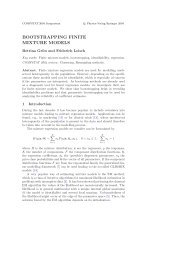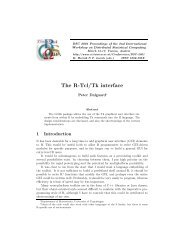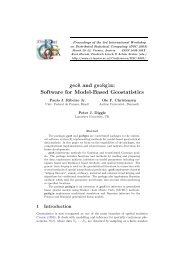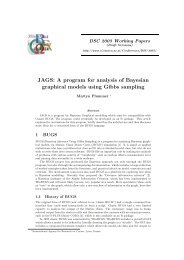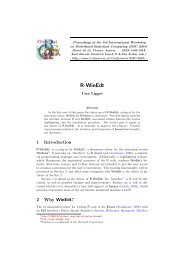Embedding R in Windows applications, and executing R remotely
Embedding R in Windows applications, and executing R remotely
Embedding R in Windows applications, and executing R remotely
Create successful ePaper yourself
Turn your PDF publications into a flip-book with our unique Google optimized e-Paper software.
crossdes — A Package for Design <strong>and</strong> R<strong>and</strong>omization <strong>in</strong> Crossover Studies<br />
Oliver Sailer<br />
Fachbereich Statistik<br />
Universität Dortmund, 44221 Dortmund, Germany<br />
February 13, 2004<br />
Design of experiments for crossover studies requires deal<strong>in</strong>g with possible order <strong>and</strong> carryover effects that<br />
may bias the results of the analysis. The classical approach to deal with those effects is to use designs<br />
balanced for the respective effects. Almost always there are effects unaccounted for <strong>in</strong> the statistical<br />
model that may or may not be of practical importance. A convenient way of address<strong>in</strong>g those effects is<br />
r<strong>and</strong>omization. Different k<strong>in</strong>ds of models, however, require different methods of r<strong>and</strong>omization. For many<br />
types of experimental designs it is not known whether a certa<strong>in</strong> method of r<strong>and</strong>omization is conformable<br />
with a certa<strong>in</strong> model.<br />
The construction of balanced designs is often based on lat<strong>in</strong> squares. The package crossdes conta<strong>in</strong>s<br />
some functions to construct designs balanced for carryover effects like the ones promoted <strong>in</strong> Wakel<strong>in</strong>g<br />
<strong>and</strong> MacFie (1995). Simulation functions are provided that test whether some basic r<strong>and</strong>omization<br />
procedure may be applied to a given design so that one-way or two-way block models give unbiased<br />
estimates for mean <strong>and</strong> variance of treatment contrasts. Here an approach similar to that of Kunert<br />
(1998) <strong>and</strong> Kunert et al. (2002) is used. The simulations done <strong>in</strong> R help to assess the use of experimental<br />
designs that are not fully balanced for carryover or period effects <strong>in</strong> crossover studies (Kunert <strong>and</strong> Sailer,<br />
2004).<br />
Supplementary functions for r<strong>and</strong>omization <strong>and</strong> check<strong>in</strong>g for balance of any given design are also provided.<br />
The beer test<strong>in</strong>g experiment presented <strong>in</strong> Kunert (1998) will be discussed as an example.<br />
References:<br />
KUNERT, J. (1998): Sensory experiments as crossover studies. Food Quality <strong>and</strong> Preference, 9,<br />
243–253.<br />
KUNERT, J., MEYNERS, M. <strong>and</strong> ERDBRÜGGE, M. (2002): On the applicability of ANOVA<br />
for the analysis of sensory data. In: 7ème Journées Européennes Agro-Industrie et Méthodes<br />
Statistiques. Proceed<strong>in</strong>gs. 129–134.<br />
KUNERT, J. <strong>and</strong> SAILER, O. (2004): On nearly balanced designs for sensory trials. In preparation.<br />
WAKELING, I.N. <strong>and</strong> MACFIE, H.J.H. (1995): Design<strong>in</strong>g consumer trials balanced for first <strong>and</strong><br />
higher orders of carry-over effect when only a subset of k samples from t may be tested. Food<br />
Quality <strong>and</strong> Preference, 6, 299–308.<br />
Keywords:<br />
NEIGHBOUR BALANCED DESIGNS, CROSSOVER STUDIES, RANDOMIZATION, SIMULA-<br />
TION




